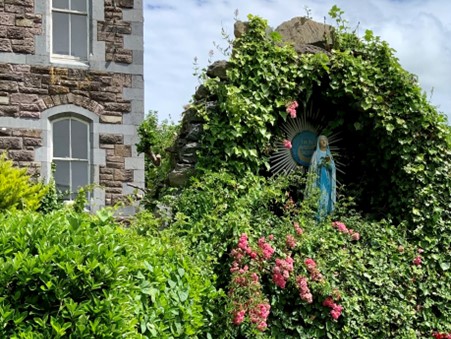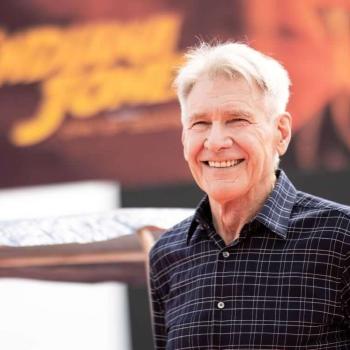
When I think I’m in danger of becoming a city-dwelling sceptic, nothing does my faith better than a countryside staycation. I have no doubt some have met God in the city, but it seems to me much more common – so the biblical witness would indicate, anyway – to find him in the wilderness.
The divine abhors the labyrinth of reinforced concrete, if Don McLean is to be believed: ‘The Father, Son, and the Holy Ghost / They caught the last train for the coast.’ Well, that being the case, and I wouldn’t second-guess Mr McLean, there’s nothing else for it other than to get out of town in pursuit!
On this occasion, the journey was from County Down to County Kerry. More specifically, we stayed in Dingle, a coastal town located on the Dingle Peninsula. ‘Dingle is a town of many charms,’ according to the settlement’s Tourism Alliance, ‘known for quality food and restaurants, interesting shops and galleries, a friendly dolphin [Fungie, fl. 1984-2020] and vibrant streetlife.’
Derry man Seamus Heaney (1939-2013) wrote an impressionistic poem about landscapes like this, “The Peninsula.” ‘When you have nothing more to say,’ the Nobel Prize winner lyricises, ‘just drive / For a day all round the peninsula.’ Which one, Seamus? Run your eyes across a map of Ireland and you’ll notice this island is ruggedly hemmed with uncountable peninsulas. Just pick the closest one, I reckon Heaney would say, then see where the day takes you.
That said, the Dingle Peninsula’s tough to beat. It’s far better than County Down’s Ards Peninsula, that’s for sure. Heaney’s poem, in its refusal to specify which peninsula forms its hinterland, speaks to the whole of Ireland. Yes, there are peninsulas all over the world – from the Arabian to the Iberian, the Korean to the Somali – but few places are as well-endowed with peninsulas as Ireland!
There is a line from one of our Anglican canticles, “Venite,” based on Psalm 95, which goes, ‘The sea is his and he made it, his hands moulded dry land.’ It was this image that entered into my mind one windswept afternoon as we descended from Conor Pass towards Dingle town, Atlantic Ocean in full view.
The grassy slopes on either side were mythical chessboards, carved up into big square fields with little sheep for micro-size pawns. (Or were they far away? Sorry, couldn’t resist!) Each and every field seemed to have its own shade of green, a one-off colour fingerprint. It’s easy to see why that old argument from intelligent design – the defence of God’s existence that runs, “nature is too complex to have come about by chance” – has had such force over the centuries.
The power of rational proofs for a god-entity, however, can only take you so far. There are also reasons – good reasons, I freely concede – to remain unconvinced. Whenever I have doubts, I ponder if I should leave spiritual writings to those with more conviction. Is it wrong – perched on the sofa with a tub of butterscotch ice cream, heretical in itself – to hold forth on stuff I believe with only limited certainty?
Psalm 95 exults in the thrill of secure faith in God. It celebrates with all who ‘cry out to him joyfully in psalms,’ but it also makes reference to the weak in faith. ‘Today if only you would hear his voice,’ it says to those whose inner ear is — as mine often is — a bit out of tune with God. In other words, keep your ears open; and where better to listen for the deity’s call than on the Wild Atlantic Way?
Christian history runs deep here. St Mary’s, Dingle, the town’s largest Roman Catholic parish church, is located on the main high-street. When I called round, folks were in preparations for a wedding, so my drop-in was a quick one: a dab of holy water, a glance at some stained-glass windows, then away!
The sanctuary visited, a stroll through the beautiful parish grounds was in order. These verdant precincts were, until recently, shared with a Presentation Sisters convent. Relatively few tourists venture in, so the spot is ideal for contemplation. Immediately to my right after I set foot in the gardens, I spotted a grotto draped in ivy. Pink buds popped out here and there at random from all the greenery.
Within this alcove, a Marian shrine, stood the Blessed Virgin. She was well-shielded from the summer heat under that stone canopy! Mary stared heavenwards, as is her trademark in Catholic iconography, with a steely, Platonic look which pierced the darkness around her. The quest after truth has to start somewhere, even from deep within the thick blackness of a cave.
Nearby, someone had built an imitation shrine with a tiny statuette of Our Lady. That was incredibly cute! On first glance, I thought she was a Disney Princess figurine, decked out in her celestial crown as Queen of Heaven, ear inclined to hear the Faithful at prayer from her miniscule throne room.
That someone took time to replicate so lovingly that original shrine, I would submit, serves to describe the theologian’s work. When we theologise, we try to represent in our (undeniably humble) human words, like a scale model does in the physical world, a much bigger subject – in our case, God!
Religious art, obviously, takes a nonverbal approach to the same task. In the gardens at St. Mary’s, for example, I passed a Sacred Heart statue. The Christ it showed was whiter than sea foam, except for the red stigmata (crucifixion wounds) on his hands and on the heart itself, which was wrapped in the traditional thorny twine. This popular piece of iconography, present in thousands of Roman Catholic households both in Ireland and abroad, strikingly depicts Our Lord’s altruistic love.
It amuses me that, in these depictions, Christ – a Nazarene peasant, who was unjustly killed on a Roman cross – is always dressed in sumptuous robes, only the very finest of togas, that emperors in his day might have worn! All the better to convey his omnipotence, I suppose: ‘For the Lord is a great God and a great king above all gods,’ to bring in Psalm 95 again.
By far the most poignant sight in the garden was its modest graveyard, which guards the remains of nuns from the former convent: Sister Bernard McAuley (d. 1978), Sister Antonius
Costello (d. 1981), Sister Evangelist Hayes (d. 1983), and on it went; a stone’s throw from where they talked and worked, ate and slept, worshipped and prayed, the whole community lies buried.
Identical crosses jutted from the ground, like sewer’s needles in a pincushion, to mark each burial plot. It was oddly tranquil, somewhat otherworldly. When their lives were over, did all the sisters begin their final rest in the knowledge and love of God? a passer-by might wonder. How many were still in the middle of an unfinished search when they quitted this realm for the next?
‘In his hand are the depths of the earth,’ claims the Psalm of Almighty God. Even in death, when we join our forebears in the sightless fathoms, we can hope to find ourselves – like the Presentation Sisters, every precious one – in God’s embrace. That image of eternal surrender to God offers far greater peace than the scramble, so prevalent in Christianity, to batten down beliefs with iron bars of assurance.
8/8/2023 7:56:54 PM








